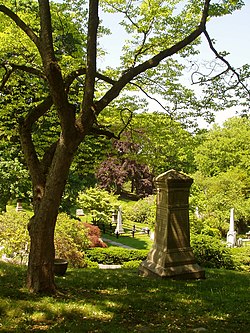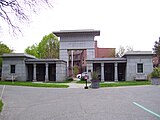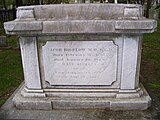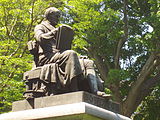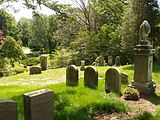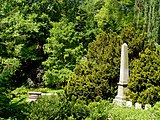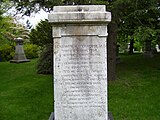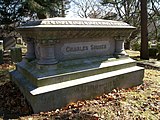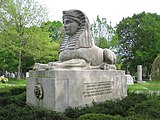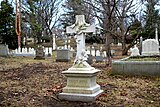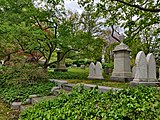
A cemetery, burial ground, gravesite, graveyard, or a green space called a memorial park, is a place where the remains of dead people are buried or otherwise interred. The word cemetery implies that the land is specifically designated as a burial ground and originally applied to the Roman catacombs. The term graveyard is often used interchangeably with cemetery, but a graveyard primarily refers to a burial ground within a churchyard.

Green-Wood Cemetery is a 478-acre (193 ha) cemetery in the western portion of Brooklyn, New York City. The cemetery is located between South Slope/Greenwood Heights, Park Slope, Windsor Terrace, Borough Park, Kensington, and Sunset Park, and lies several blocks southwest of Prospect Park. Its boundaries include, among other streets, 20th Street to the northeast, Fifth Avenue to the northwest, 36th and 37th Streets to the southwest, Fort Hamilton Parkway to the south, and McDonald Avenue to the east.

The Cemetery of the Evergreens, also called The Evergreens Cemetery, is a non-denominational rural cemetery along the Cemetery Belt in Brooklyn and Queens, New York City. It was incorporated in 1849, not long after the passage of New York's Rural Cemetery Act spurred development of cemeteries outside Manhattan. For a time, it was the busiest cemetery in New York City; in 1929 there were 4,673 interments. Today, the Evergreens is the final resting place of more than 526,000 people.

Hollywood Cemetery is a historic rural cemetery located at 412 South Cherry Street in the Oregon Hill neighborhood of Richmond, Virginia. It was established in 1847 and designed by the landscape architect John Notman. It is 135-acres in size and overlooks the James River. It is the only cemetery other than Arlington National Cemetery that contains the burials of two United States Presidents, James Monroe and John Tyler.

Mount Pleasant Cemetery is a historic rural cemetery in the North Ward of Newark in Essex County, New Jersey, United States. It is located on the west bank of the Passaic River in Newark's Broadway neighborhood, opposite Kearny. It occupies approximately 40 acres and was designed by Horace Baldwin.

Abney Park cemetery is one of the "Magnificent Seven" cemeteries in London, England.

Forest Hills Cemetery is a historic 275-acre (111.3 ha) rural cemetery, greenspace, arboretum, and sculpture garden in the Forest Hills section of Jamaica Plain, a neighborhood in Boston, Massachusetts. The cemetery was established in 1848 as a public municipal cemetery for Roxbury, Massachusetts, but was privatized when Roxbury was annexed to Boston in 1868.

Lowell Cemetery is a cemetery located in Lowell, Massachusetts. Founded in 1841 and located on the banks of the Concord River, the cemetery is one of the oldest garden cemeteries in the nation, inspired by Mount Auburn Cemetery in Cambridge, Massachusetts. Many of Lowell's wealthy industrialists are buried here, under ornate Victorian tombstones. A 73-acre (30 ha) portion of the 84 acres (34 ha) cemetery was listed on the National Register of Historic Places in 1998.

A rural cemetery or garden cemetery is a style of cemetery that became popular in the United States and Europe in the mid-19th century due to the overcrowding and health concerns of urban cemeteries. They were typically built 1–5 mi (1.6–8.0 km) outside of the city, far enough to be separated from the city, but close enough for visitors. They often contain elaborate monuments, memorials, and mausoleums in a landscaped park-like setting.

Hillside Cemetery is located on Mulberry Street in Middletown, New York, United States. Opened in 1861, it was designed in the rural cemetery style by Calvert Vaux and Frederick Law Olmsted, later noted for their collaboration on Central Park. There are several thousand graves, some with excellent examples of 19th-century funerary art.

Jacob Bigelow was an American physician, botanist and botanical illustrator. He was architect of Mount Auburn Cemetery in Cambridge, Massachusetts, husband to Mary Scollay, and the father of physician Henry Jacob Bigelow. The standard author abbreviation Bigelow is used to indicate this person as the author when citing a botanical name.

The 1870 Mount Auburn Cemetery Reception House is an historic building that originally served as the reception house of Mount Auburn Cemetery in Cambridge, Massachusetts. The building is located at 583 Mount Auburn Street, across the street from the cemetery, and is no longer part of the cemetery. A new reception house was built on the cemetery grounds in 1896.
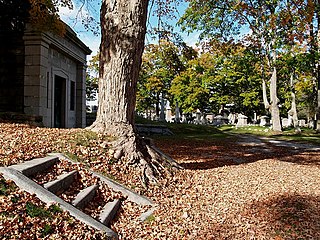
Mount Pleasant Cemetery is an historic cemetery at Crocker, Cohannet, and Barnum Streets in Taunton, Massachusetts. Opened in 1836, but based on a family burial ground dating to the early 18th century, it is the fourth garden cemetery in the U.S. rural cemeteries, based on the early Victorian model of Mount Auburn Cemetery in Cambridge, Massachusetts. The cemetery was listed on the National Register of Historic Places in 2002.

Pine Grove Cemetery is a cemetery whose main entrance is on Boston Street in Lynn, Massachusetts. It was established in the mid-19th century and it consists of 82 developed acres. There are approximately 88,000 to 90,000 interments at the cemetery.

Bradlee, Winslow & Wetherell (1872–1888) was an architecture firm in Boston, Massachusetts. Its principals were Nathaniel Jeremiah Bradlee (1829–1888), Walter Thacher Winslow (1843–1909) and George Homans Wetherell (1854–1930). Most of the firm's work was local to Boston and New England, with a few commissions as far afield as Seattle and Kansas City.

Rural Cemetery is located on 180 Grove Street in Worcester, Massachusetts. More than 13,000 people are buried at the cemetery, including congressmen, mayors, governors, and professional people.

Alexander Wadsworth (1806—1898) was an American landscape architect and surveyor, best known for his work on the Mount Auburn Cemetery in Cambridge, Massachusetts. Born in Hiram, Maine, Wadsworth studied civil engineering at Gardiner Lyceum before beginning his work as a surveyor in the Boston, Massachusetts area. He collaborated with Henry A. S. Dearborn on the topographic details of Mount Auburn Cemetery, and had a successful career designing parks and suburban subdivisions, primarily in eastern Massachusetts. Along with Francis Peabody, he also designed the Harmony Grove Cemetery in Salem, Massachusetts.
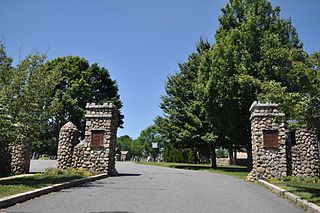
The Rural Cemetery and Friends Cemetery are a pair of connected cemeteries at 149 Dartmouth Street in New Bedford, Massachusetts United States. They occupy an irregular parcel of land more than 90 acres (36 ha) in size on the west side of the city. Established in 1837, the Rural Cemetery was the fifth rural cemetery in the nation, after Mount Auburn Cemetery, Mount Hope Cemetery, Mount Pleasant Cemetery, and Laurel Hill Cemetery. In its early days it was criticized as lacking some of the natural beauty afforded by rolling terrain; the early sections were laid out in rectilinear manner on relatively flat terrain. The cemetery was a popular burial site, including notably the landscape artist Albert Bierstadt and Governor of Massachusetts John H. Clifford.
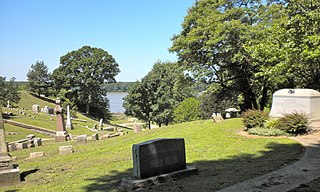
Woodland Cemetery is a historic cemetery located at 1020 South Fifth Street in Quincy, Illinois. Planned by politician John Wood and opened in 1846, the cemetery is a product of America's rural cemetery movement of the mid-nineteenth century. The cemetery's grave markers include smaller Victorian monuments and large Gothic Revival and Neoclassical structures. The cemetery was added to the National Register of Historic Places in 2002.
